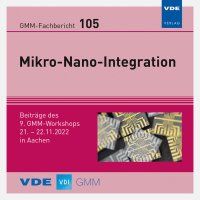Zinc Oxide Nanowire Arrays Growth on Patterned Silicon Substrate for Π-ezoelectric Energy Harvesting
Konferenz: Mikro-Nano-Integration - 9. GMM-Workshop
21.11.2022 - 22.11.2022 in Aachen, Germany
Tagungsband: GMM-Fb. 105: Mikro-Nano-Integration
Seiten: 5Sprache: EnglischTyp: PDF
Autoren:
Anang, Frank Eric Boye (Institute for Semiconductor Technology, TU Braunschweig, Germany & Scientific Metrology Department, Ghana Standards Authority, Accra, Ghana)
Wang, Zhenjun; Xu, Jiushuai; Schmidt, Angelika; Peiner, Erwin (Institute for Semiconductor Technology, TU Braunschweig, Germany)
Cain, Markys (Electrosciences Ltd, Farnham, Surrey, United Kingdom)
Inhalt:
Piezoelectric energy harvesting has in recent years technologically advanced and gained excellent momentum due to its enormous energy efficiency and numerous environmental benefits. Zinc oxide (ZnO), on the other hand, continues to remain afloat as a material of choice for the manufacture of a wide range of energy harvesting devices as well as self-powered sensors. In this work, a low-temperature (<100 °C) aqueous solution growth of uniformly aligned ZnO nanowire arrays (NWAs) on a cost-effective, easy synthesis and compatible silicon (Si) substrate is realized. Compared to its counterparts such as bulk or layers, NWAs have the advantage of being miniaturized and integrated with other devices. On the other hand, the power density of NWAs is higher due to the small active thickness. Furthermore, their higher piezoelectric coefficient and larger elastic deformation when tiny external stimulus are applied for piezo potential generation, makes ZnO NWAs the material of choice. The ZnO NWAs in our experiment were selectively grown on patterned Si substrate surfaces by a devised Microelectromechanical System (MEMS)-compatible chemical-bath deposition (CBD) method. The patterned nanowire growth has the advantage of improved output performance and independent working mode of each region. To facilitate nucleation between the ZnO NWs and the Si substrate, a low- temperature, low-cost direct-current (DC) sputtering of Zn thin film was employed for seed layer deposition. The sputtered Zn thin film was annealed in air at a temperature of 600 °C for 60 min for oxidation to obtain a crystalline ZnO seed layer. Scanning Electron Microscopy (SEM) images of the fabricated ZnO NWAs taken shows that the NWs are well aligned with diameters and lengths of (200 ± 53) nm and (1800 ± 99) nm, respectively. This study, therefore, demonstrates the potential for MEMS fabrication of ZnO-based piezoelectric nanogenerator (PENG) on Si substrate. The proposed device, with a measured output voltage of 8 mV for a patterned region when finger-pressed, is intended to be able to provide the power needs for health-care monitoring devices’ application. The demonstration of this concept paves way for the fabrication of a state-of-the-art ZnO-based PENG on a flexible polymer substrate in our future work.


